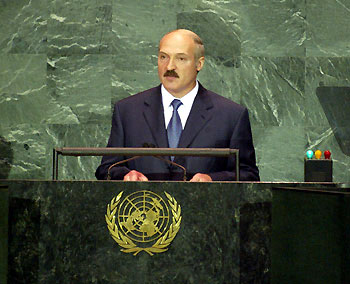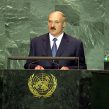
LUKASHENKA AT THE UN: PROPAGANDA AND INVECTIVE
Publication: Eurasia Daily Monitor Volume: 2 Issue: 173
By:

Though the domestic situation in Belarus is tightly controlled by the authorities, the administration of President Alexander Lukashenka has been isolated internationally to an increasing extent. It was designated an “outpost of tyranny” by U.S. Secretary of State Condoleezza Rice, and the U.S. administration and the European Union have made no secret of their preference for a change of regime. However, the Lukashenka leadership has been presented recently with some propaganda triumphs that may help to perpetuate the image propagated by the Belarusian media of a strong leader of a stable republic, offering new international initiatives.
The first “triumph” was the collapse of the Tymoshenko government in Ukraine, which provided some relief for official Minsk from the threat of a “color revolution” and also allowed the president to make some condescending comments about the need for President Viktor Yushchenko to take such a decision in the face of impending anarchy (Belarus Today, September 13-19).
The second event provided a much broader stage, namely the 60th session of the General Assembly of the United Nations. As the UN enjoys extra-territorial status, the U.S. Embassy in Minsk was obliged to grant a visa to the delegation from Belarus. It turned into a propaganda coup for Lukashenka. His departure for New York was the main item featured on national television. On September 16, the banner headline in the newspaper Respublika, in bold letters, read: “The Visit of Alexander Lukashenka to the United States of America,” thus failing to distinguish a state visit with one to the UN specifically (Respublika, September 16).
The Belarusian delegation included, besides Lukashenka, the Minister of Foreign Affairs, Syarhey Martynau, the head of Belarus’s permanent mission to the UN, Andrey Dapykunas, and Belarus’s ambassador to the United States, Mikhail Khvastou. The press service of the president in New York included 14 representatives of the Belarusian media, three TV stations (BT, ANT, and STB), the information agencies BelTA and Interfax, and the newspaper Sovetskaya Belorussiya (Narodnaya Volya, September 16).
According to official reports, Lukashenka’s schedule was a full one that included an interview with the Russian service of Radio UN, a speech at the plenary session, various bilateral discussions, interviews with journalists from NTV and the Belarusian mass media, and participation in the ceremony for signing the international convention against nuclear terrorism.
Lukashenka’s speech contained a strong attack on the United States, which he portrayed as the only global power since the collapse of the USSR, a state that guaranteed world balance. The past ten years, he stated, have seen the removal of Yugoslavia from the map of Europe and unwarranted conflicts in Afghanistan and Iraq, the latter in direct contravention of a UN resolution. He decried what he perceives as the domination of a U.S. perspective of the world, which tries to enforce regime change in states such as Iran and North Korea (by implication, Belarus also). He added that Belarusians have a peaceful state with no conflicts and no problems with their neighbors; they gave up nuclear weapons voluntarily and created a successful union with Russia (Segodnya [Minsk], September 16).
The reality was that, despite statements about bilateral discussions, no world leaders other than those from Iran and Iraq wanted to speak with Lukashenka. For the most part he talked to members of his own delegation, which faithfully reported his comments back to Minsk. In New York he stayed at the Waldorf Astoria hotel, which was relatively extravagant at a cost of more than $1,000 to the Belarusian taxpayer. His route to the UN was blocked partially by demonstrators carrying white-red-white flags (now banned in Belarus, but the national flag in 1991-95) and banners reading “Belarus-Yes! Lukashenka-NO!” Among the protesters was clearly visible the tall figure of the exiled leader of the Christian Conservative Party of the BNF, Zyanon Paznyak (Narodnaya volya, September 16).
So what did the trip achieve? The president has tried to foster the illusion of a figure being at the center of world affairs, and — as speculated by one newspaper — the apparent initiator of a new “anti-American movement” (Narodnaya volya, September 17). Clearly there is a wide gap between the image presented by the authorities of a peaceful state enjoying good relations with neighbors (as Poland and Ukraine would attest) and the reality.
Similarly the “successful union” with Russia has not yet materialized — in fact it is beset with problems. But the New York visit was a boon to official propaganda on the eve of an election year. It provided viewers with images of their president making a major international speech with world leaders in attendance (at least officially, since the coverage never revealed the audience or the reaction), and lambasting the world’s only superpower. It was thus an opportunity too good to be missed: one that ostensibly enhanced the official image of a strong and protective leader.




